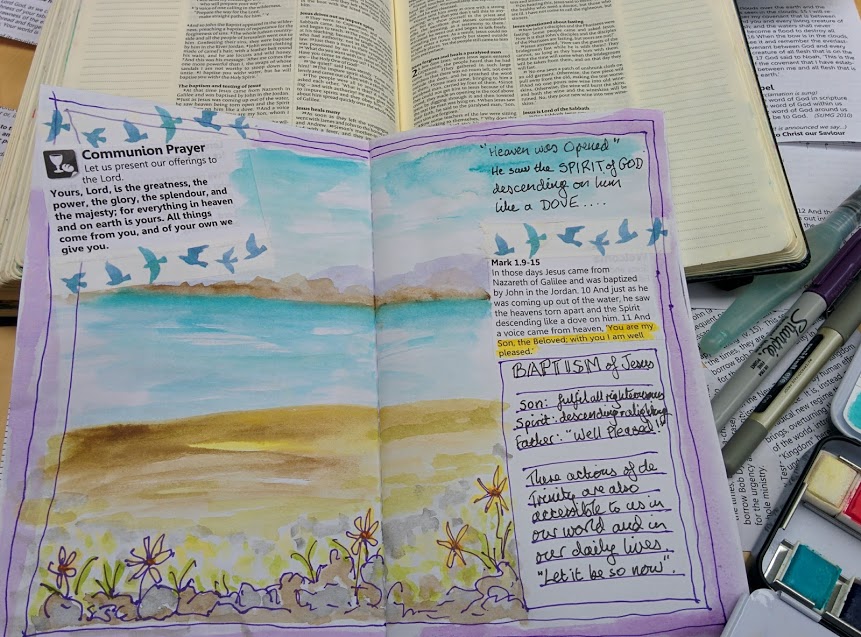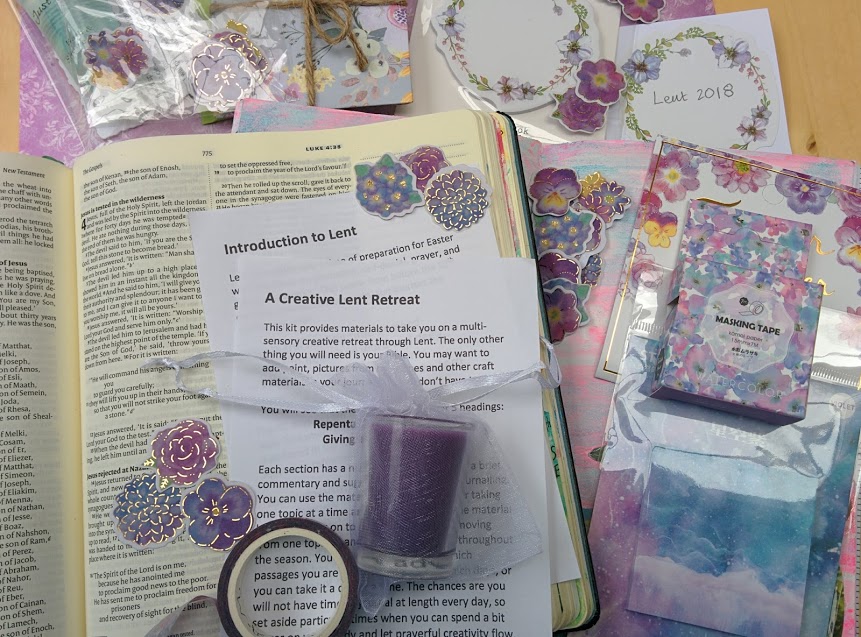
This Lent, we’re working with Jane MacLaren to bring you an online Lent group, looking at the traditional Gospels through the format of Bible journalling. Jane is a non-stipendiary priest with a passion for helping people explore their relationship with God through this technique.
Follow along here, sign up for emails about the course and join our Facebook group to connect with others on the course from across the diocese. If you want a little more background about this course, read the intro post here.

Bible Journalling Notes for the First Sunday in Lent 2018: Mark 1: 9-15
The gospel reading for the first Sunday in Lent looks at the very beginning of Jesus’ ministry. Mark 1: 9-15 gives us four little snapshots:
-
the Baptism of Jesus (verses 9-11)Lent
-
his temptation in the wilderness (verses 12-13)
-
the imprisonment of John the Baptist (verse 14)
-
the beginning of Jesus preaching ministry (verses 14-15).
There are no details, no embellishments, and these highly significant episodes are simply alluded to in Mark’s characteristically succinct style. There are more details in other gospels.
We’re going to focus on Jesus’ baptism
In order to understand what it means for us we need to dig a little deeper. We need to find the human story, the sights, sounds, colours and smells of the occasion. Creative Bible journalling is a great way of exploring this. It helps us engage with God and his word at a more visceral level than the purely intellectual and engages different bits of our brain.
To explore Jesus’ baptism we will need to look a little further than Mark’s gospel. The following references will help us get a fuller picture:
-
Matthew 3:13-4:17
-
Luke 3:21-22 and 4:1-15
Here are some suggestions for getting started with your first Bible journalling session:
-
Read the gospel accounts of Jesus’ baptism in Matthew and Luke.
Does anything jump out at you – a single word, phrase, sensory picture or something else?
Jot it down on your page. -
Then begin to imagine the scene, what colours and images come to mind? What can you smell? How hot is it?
While you are thinking about this, add colours to your page – try a wash of watercolour paint or
some coloured pens or pencils. Enjoy the simple physical process of applying colour.
Add some images – you can tear them from magazines or leaflets, draw them yourself or keep it
abstract – you know what it all symbolises for you. -
Look at the gospel reference again – is there anything to add or pray?
Who are the main characters? How would you like to represent them?
What does this tell us about the person of Jesus? What does it tell us about the Trinity? -
Are there any other key words you want to include?
Keep adding and playing with colours and images, aware of God’s presence with you.
Have fun with it. You are not looking for a great piece of art or a great revelation. This is a little time
of quiet. Enjoy the exploration. Our Creator God is with you as you create something on your page. -
You cannot get this ‘wrong’. It’s about your prayers, your exploration and your creativity. It’s your
journal, it is unique to you and no one is judging you!
I’ve found that the less you worry about what you’re ‘achieving’ and the more you enjoy the freedom of
the process of moving colours and images around your page, the more space you have for God. Maybe by
the end something will have become clear to you, or maybe you will be more aware of God’s presence or
will feel more peaceful. If you’ve simply had a few happy minutes doing something creative, that’s an
excellent use of time! You are made in the image of God, and you have nourished some of your God-given
creativity.
Here’s a short 3-minute video of Jane walking you through her journalling of the Baptism of Jesus.
Here’s a downloadable pdf of the notes for you to print off. It’s an A5 landscape, to fit neatly into your journal:
Bible Journalling Notes for Lent 1_ Mark 1_ 9-15 Jesus’ Baptism
Stay tuned for a special Bonus post coming later tonight, with a reflection on Jesus’ Temptation in the Wilderness.
Focus on Technique
1. Edging your page
Some people find a blank page inviting and full of possibilities – anything could happen there! Others find a blank page rather intimidating. Edging your pages is a great way tomake a start – somehow a page with decoration around the edges is more inviting and easier to broach than a blank one.
Try edging the first few pages in your journal with some washi tape. You could use it as a basis for you colour scheme or patterns, or simply as an outline to anything else you may add to the page. Alternatively you could draw or paint a border – a simple hand-drawn line will be enough to get you started and if it isn’t completely straight it will look more interesting.
For the uninitiated, washi tape is a Japanese paper tape with beautiful patterns. It’s easy to cut or tear to the length you want and is easily repositionable. It is increasingly available in the UK but can vary enormously in price so it’s worth shopping around.

(Note from the Editor:
If you’ve not yet collected all your bits and pieces together for journalling, and you want a quick and easy option, Jane has produced some beautiful kits to go along with this course. They include washi tape, along with a journal to write in, sticky notes, list pages, cardstock pieces, stickers, sensory prayer prompts and additional journalling prompts on Lenten themes and they cost £25. There aren’t very many available, so email Jane directly to order a kit and it’ll be winging its way to you in no time.)
